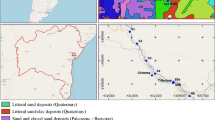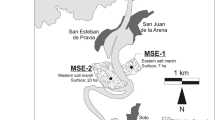Abstract
The Litavka River (length 56 km, watershed area 630 km2, average flow at the outlet to the Berounka River 2.57 m3 s−1) drains the historical mining, ore processing, and smelting region of Příbram. This Ag–Pb–Zn±Sb ore district (production from the thirteenth century to 1978, locally to 1980) is known for extensive heavy metal contamination. Recent contamination of the Litavka River system is mostly related to the erosion of contaminated soils and fluvial floodplains sediments, especially from a low-gradient river section located immediately below the ore district, where the fine-grained floodplain sediments are from 1.0 to 1.7 m thick. Radiocarbon accelerator mass spectrometry dating of charcoal fragments separated from one floodplain profile showed calibrated 14C age in the range AD 1220–1284 at a depth of 1.2 m below the surface, while depths of 0.4 and 0.8 m yielded ages in the range AD 1680–1939. Formation of this floodplain was related to disturbance of the river equilibrium resulting from deforestation and the influx of fine-grained material from ore processing, including historical failures of settling ponds. Fluxes of heavy metals during flood events in the Litavka River were studied 35 km downstream below the ore district. Metals are transported here mostly (more than 99% for Pb) in the form of suspended particulate matter (SPM), which at the outlet of the Litavka River contains 2,016 mg kg−1 Zn, 918 mg kg−1 Pb, and 25.5 mg kg−1 Cd on average. During a snowmelt-related minor flood event between March 25 and 29, 2006 (peak flow 36.6 m3 s−1), the river transported 2,400 tonnes of SPM during 4 days, containing 74 kg of Cd, 2,954 kg of Pb, and 5,811 kg of Zn. During larger floods (water flows above 55 m3 s−1 have occurred here 27 times during the last 77 years), the contamination is more diluted by material eroded in the floodplain along the middle and lower river course.






Similar content being viewed by others
References
Baborowski, M., von Tümpling Jr, W., & Friese, K. (2004). Behaviour of suspended particulate matter (SPM) and selected trace metals during the 2002 summer flood in the River Elbe (Germany) at Magdeburg monitoring station. Hydrology and Earth System Sciences, 8, 135–150.
Bambas, J. (1990). Ore district of Březové Hory. Příbram: Hornická Příbram ve vědě a technice (In Czech).
Borůvka, L., & Drábek, O. (2004). Heavy metal distribution between fractions of humic substances in heavily polluted soils. Plant, Soil and Environment, 50, 339–345.
Borůvka, L., Huan-Wei, C., Kozák, J., & Krištoufková, S. (1996). Heavy contamination of soil with cadmium, lead and zinc in the alluvium of the Litavka River. Rostlinná Výroba, 42, 543–550.
Bronk Ramsey, C. (1995). Radiocarbon calibration and analysis of stratigraphy: The OxCal program. Radiocarbon, 37, 425–430.
Bronk Ramsey, C. (2001). Development of the radiocarbon calibration program OxCal. Radiocarbon, 43, 355–363.
Coynel, A., Schafer, J., Blanc, G., & Bossy, C. (2007). Scenario of particulate trace metal and metalloid transport during a major flood event inferred from transient geochemical signals. Applied Geochemistry, 22, 821–836. doi:10.1016/j.apgeochem.2006.10.004.
Ettler, V., Legendre, O., Bodénan, F., & Touray, J. C. (2001). Primary phases and natural weathering of old lead-zinc pyrometallurgical slag from Příbram, Czech Republic. Canadian Mineralogist, 39, 873–888. doi:10.2113/gscanmin.39.3.873.
Ettler, V., Mihaljevič, M., & Komárek, M. (2004). ICP-MS measurements of lead isotopic ratios in soils heavily contaminated by lead smelting: tracing the sources of pollution. Analytical and Bioanalytical Chemistry, 378, 311–317. doi:10.1007/s00216-003-2229-y.
Ettler, V., Vaněk, A., Mihaljevič, M., & Bezdička, P. (2005). Contrasting lead speciation in forest and tilled soils heavily polluted by lead metallurgy. Chemosphere, 58, 1449–1459. doi:10.1016/j.chemosphere.2004.09.084.
Ettler, V., Mihaljevič, M., Šebek, O., Molek, M., Grygar, T., & Zeman, J. (2006). Geochemical and Pb isotopic evidence for sources and dispersal of metal contamination in stream sediments from the mining and smelting district of Příbram, Czech Republic. Environmental Pollution, 142, 409–417. doi:10.1016/j.envpol.2005.10.024.
Ettler, V., Navrátil, T., Mihaljevič, M., Rohovec, J., Zuna, M., Šebek, O., et al. (2008). Mercury deposition/accumulation rates in the vicinity of a lead smelter as recorded by a peat deposit. Atmospheric Environment, 42, 5968–5977. doi:10.1016/j.atmosenv.2008.03.047.
Hána, J., & Zítek, S. (2000). Floods of Litavka River and their influence on the landscape. In J. Němec (Ed.), Litavka 2000 (pp. 53–55). Příbram: Okresní úřad (In Czech).
Hanisch, C., Zerling, L., & Junge, F. W. (2004). Suspended matter transport in fluviatile systems—a flood balance. Zeitschrift für Geologische Wissenschaften, 32, 322–326.
IAEA. (2005). Fluvial sediment transport: Analytical techniques for measuring sediment load. IAEA-TECDOC-1461. Vienna: International Atomic Energy Agency.
Kašpárek, L. (1984). About the floods of 1872 and 1981 on Litavka River and their importance for estimation of N-year floods. Práce a Studie ČHMÚ, 7, 1–56 In Czech.
Koudelák, P., Stránský, D., & Handová, Z. (2000). The influence of urbanized areas on the trasport of pollutants and water quality in the Litavka River. In J. Němec (Ed.), Litavka 2000 (pp. 66–70). Příbram: Okresní úřad (In Czech).
Koželuh, M., & Kule, L. (2004). The quality of water and sediments in the Litavka River drainage area. Poster presented at XXIIth Danube Conference, Brno 30.8.–2.9.2004.
Langhammer, J., Matoušková, M., Kaplická, M., Kučera, Z., Oliva, M., & Volaufová, L. (2004). Contamination of water courses by specific contamination in the watershed of Berounka River. Final report of the project GAUK č. 211/2001/B/GEO. Praha: Charles University in Prague, Faculty of Science, Department of Physical Geography and Geoecology. (In Czech).
Macklin, M. G., Brewer, P. A., Hudson-Edwards, K. A., Bird, G., Coulthard, T. J., Dennis, I. A., et al. (2006). A geomorphological approach to the management of rivers contaminated by metal mining. Geomorphology, 79, 423–447. doi:10.1016/j.geomorph.2006.06.024.
Mihaljevič, M., Zuna, M., Ettler, V., Chrastný, V., Šebek, O., Strnad, L., et al. (2008). A comparison of tree rings and peat deposit geochemical archives in the vicinity of a lead smelter. Water, Air, and Soil Pollution, 188, 311–321. doi:10.1007/s11270-007-9546-2.
Miller, J. R. (1997). The role of fluvial geomorphic processes in the dispersal of heavy metals from mine sites. Journal of Geochemical Exploration, 58, 101–118. doi:10.1016/S0375-6742(96)00073-8.
Mrňa, F. (1979). Geochemical exploration of the contents of some trace elements in the stream sediments of central and southern Bohemia. Journal of Geological Sciences, Economic Geology. Mineralogy, 20, 155–215.
Navrátil, T., Rohovec, J., & Žák, K. (2008). Floodplain sediments of the 2002 catastrophic flood at the Vltava (Moldau) River and its tributaries: mineralogy, chemical composition, and post-sedimentary evolution. Environmental Geology, 56, 399–412. doi:10.1007/s00254-007-1178-8.
Pelletier, J. D., DeLong, S. B., Cline, M. L., Harrington, C. D., & Keating, G. N. (2008). Dispersion of channel-sediment contaminants in distributary fluvial systems: Application to fluvial tephra and radionuclide redistribution following a potential volcanic eruption at Yucca Mountain. Geomorphology, 94, 226–246. doi:10.1016/j.geomorph.2007.05.014.
Rieuwerts, J. S., Farago, M., Cikrt, M., & Bencko, V. (1999). Heavy metal concentrations in and around households near a secondary lead smelter. Environmental Monitoring and Assessment, 58, 317–335. doi:10.1023/A:1006058331453.
Rieuwerts, J. S., Farago, M. E., Cikrt, M., & Bencko, V. (2000). Differences in lead bioavailability between a smelting and mining area. Water, Air, and Soil Pollution, 122, 203–229. doi:10.1023/A:1005251527946.
Šrein, V., Šťastný, M., & Šreinová, B. (2005). The partial research of the technological enrichment of sediments by selected heavy elements. Bulletin mineralogicko-petrologického oddělení Národního Muzea, 13, 211–217 Praha. (In Czech).
Sucharová, J., & Suchara, I. (2004). Distribution of 36 element deposition rates in a historic mining and smelting area as determined through fine-scale biomonitoring techniques. Part I: Relative and absolute current atmospheric levels detected by moss analyses. Water, Air, and Soil Pollution, 153, 205–228. doi:10.1023/B:WATE.0000019944.33209.83.
Suchara, I., & Sucharová, J. (2004). Distribution of 36 element deposition rates in a historic mining and smelting area as determined through fine-scale biomonitoring techniques. Part II: Relative long-term accumulated atmospheric deposition levels. Water, Air, and Soil Pollution, 153, 229–252. doi:10.1023/B:WATE.0000019915.70739.bf.
Šulcek, Z., & Povondra, P. (1989). Methods of decomposition in inorganic analysis. Boca Raton, Florida: CRC.
Swartjes, F. A. (1999). Risk-based assessment of soil and groundwater quality in the Netherlands: Standards and remediation urgency. Risk Analysis, 19, 1235–1249.
Vaněk, A., Borůvka, L., Drábek, O., Mihaljevič, M., & Komárek, M. (2005). Mobility of lead, zinc and cadmium in alluvial soils heavily polluted by smelting industry. Plant, Soil and Environment, 51, 316–321.
Vaněk, A., Ettler, V., Grygar, T., Borůvka, L., Šebek, O., & Drábek, K. (2008). Combined chemical and mineralogical evidence for heavy metal binding in mining- and smelting-affected alluvial soils. Pedosphere, 18, 464–478. doi:10.1016/S1002-0160(08)60037-5.
Velfl, J. (2007). Time tracking. Mining activities in Central Bohemia. Praha: Středočeský kraj.
Veselý, J., Majer, V., Kučera, J., & Havránek, V. (2001). Solid-water partitioning of elements in Czech Rivers. Applied Geochemistry, 16, 437–450. doi:10.1016/S0883-2927(00)00041-X.
Villarroel, L. F., Miller, J. R., Lechler, P. J., & Germanoski, D. (2006). Lead, zinc, and antimony contamination of the Rio Chilco–Rio Tupiza drainage system, southern Bolivia. Environmental Geology, 51, 283–299. doi:10.1007/s00254-006-0326-x.
Vlašímský, P. (1982). The Příbram ore district: rock geochemistry and potential sources of hydrothermal mineralization. Journal of Geological Sciences, Economic Geology. Mineralogy, 24, 49–99.
Vlašímský, P., Žák, K., Komínek, J., & Patočka, F. (1995). Late Variscan hydrothermal uraninite-anthraxolite deposits of the Příbram ore region, Bohemian Massif: geology and genetic features of the largest uranium vein-type deposits of the Czech Republic. In J. Pašava, B. Kříbek, & K. Žák (Eds.), Mineral deposits: from their origin to their environmental impacts. Proceedings of Third Biennial SGA Meeting, Prague, August 28 to 31, 1995 (pp. 397–400). Rotterdam: Balkema.
Walling, D. E., Owens, P. N., Carter, J., Leeks, G. J. L., Lewis, S., Meharg, A. A., et al. (2003). Storage of sediment-associated nutrients and contaminants in river channel and floodplain systems. Applied Geochemistry, 18, 195–220. doi:10.1016/S0883-2927(02)00121-X.
Žák, K., & Dobeš, P. (1991). Stable isotopes and fluid inclusions in hydrothermal deposits: The Příbram ore region. Praha: Academia.
Acknowledgments
All chemical sample decompositions and analyses were performed in the laboratories of the Institute of Geology AS CR, v. v. i., Prague, except for carbon analyses, which were done in the laboratories of the Czech Geological Survey in Prague. We thank M. Koželuh, B. Nekut, and L. Polya (Povodí Vltavy, State Enterprise) for valuable information and data about the Litavka River. The help of S. Sánchez de la Nieta Morote during field sampling was appreciated. Field observations on geomorphologic evolution of the Litavka River floodplain done by V. Cílek and R. Mikuláš (Institute of Geology AS CR, v. v. i., Prague) improved our understanding of the river system evolution. We thank D. W. Hardekopf for the careful reading and corrections in the final version of the manuscript. This study was performed as a part of the project IAA300130505 of Institute of Geology, AS CR, v. v. i., within research program AV0Z30130516.
Author information
Authors and Affiliations
Corresponding author
Rights and permissions
About this article
Cite this article
Žák, K., Rohovec, J. & Navrátil, T. Fluxes of Heavy Metals from a Highly Polluted Watershed During Flood Events: A Case Study of the Litavka River, Czech Republic. Water Air Soil Pollut 203, 343–358 (2009). https://doi.org/10.1007/s11270-009-0017-9
Received:
Accepted:
Published:
Issue Date:
DOI: https://doi.org/10.1007/s11270-009-0017-9




